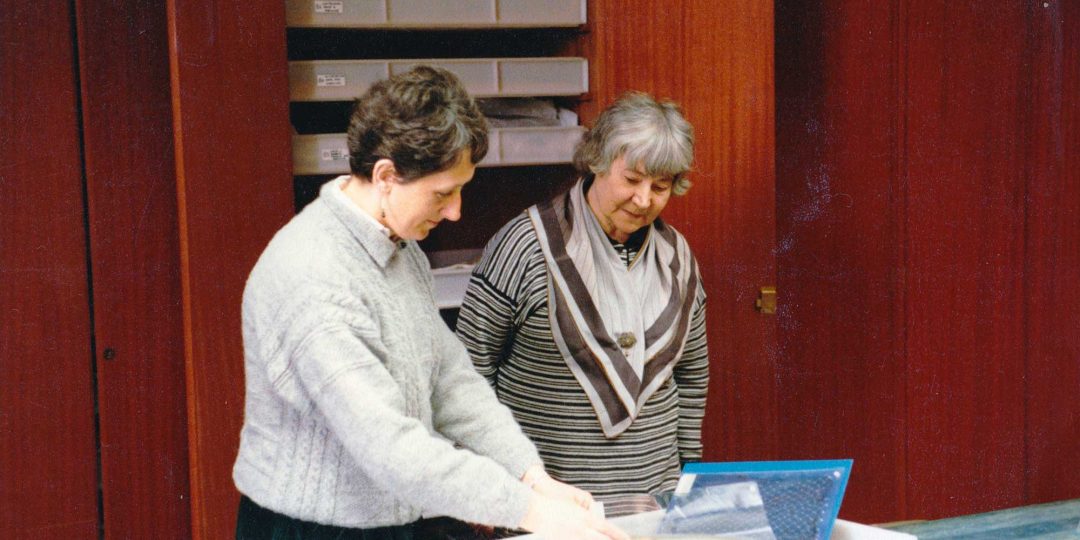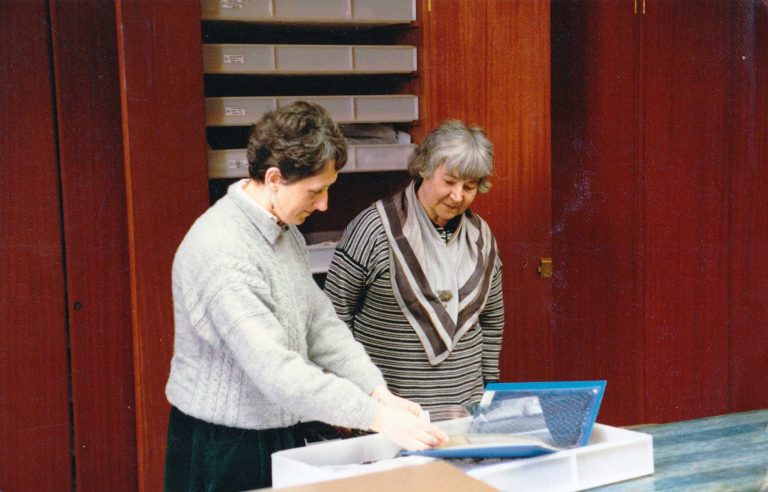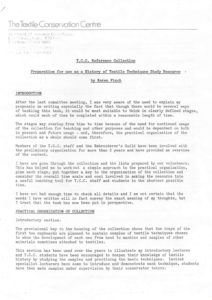Preparation for use as a History of Textile Techniques Study Resource
- Nov 16, 2018
- By Stephen Cole
- In Articles + Papers
August 19th, 1986
After the last committee meeting, I was very aware of the need to explain my proposals in writing especially the fact that though there would be several ways of tackling this task, it would be most suitable to think in clearly defined stages, which could each of them be completed within a reasonable length of time.
The stages may overlap from time to time because of the need for continued usage of the collection for teaching and other purposes and would be dependent on both is present and future usage – and, therefore, the practical organisation of the collection as a whole should come first.
Members of the T.C.C. staff and the Embroiderer’s Guild have been involved with the preliminary organisation for more than 2 years and have provided an overview of the content.
I have now gone through the collection and the lists prepared by our volunteers. This has helped me to work out a simple approach to the practical organisation, plan each stage, put together a key to the organisation of the collection and consider the overall time scale and cost involved in making the resource into a useful teaching tool for T.C.C. staff and students in the shortest possible time.
I have not had enough time to check all details and I am not certain that the words I have written will in fact convey the exact meaning of my thoughts, but I trust that the task has now been put in perspective.
Introductory section
The provisional key to the housing of the collection shows that the trays of the first two cupboards are planned to contain samples of textile techniques chosen to show the development of each one from hand to machine and samples of other materials sometimes attached to textiles.
This section has been used over the years to illustrate my introductory lectures and T.C.C. students have been encouraged to deepen their knowledge of textile history by studying the samples and practising the basic techniques. Invited specialist lecturers have come to introduce and demonstrate each technique, students have then made samples under supervision by their conservator tutors.
Equipment including spindles, spinning wheels, frames for sprang and tapestry, tablet and shaft looms, lace-pillows and bobbins, braidlooms and embroidery frames are available in the attic.
Chronological section
The objects in the lower part of the next six cupboards should show examples of the various techniques as they changed and developed during progressive cycles of fashion and consequent industrial changes.
The upper cupboards on the library side will contain duplicate material for teaching and research and material in need of cleaning and conservation before deciding to which section they should be assigned.
The upper cupboards on the wall adjoining the Gallery will contain more duplicate material and the demonstration material used for the upholstery and conservation lectures.
The remaining cupboards have hanging space in the lower cupboards and space for specific lecture and demonstration material in the upper part.
The volunteers have numbered and labelled much of the material and could begin to mount the smaller pieces in their various groups. Before proceeding with this, we will need a discussion with all concerned with the use of the collection for the purpose of considering methods of mounting each category that will fit in with both preventive conservation and security requirements.
The responsibility for the supervision of the maintenance and growth of the library and reference collection is listed under the typical duties of the Head of Studies and Research. I believe that to make the collection available and maintainable, a framework for its organisation is necessary and I have, therefore, prepared stages based on present content and practical use that will fit in with the teaching and provide opportunities for participation by staff and students alike.
The stages in the preparation of the Resource are:
- Preliminary organisation of Collection.
- Selection of objects for each category.
- Labelling each piece with numbers and simple description of technique and presumed function.
- Finding relevant illustrations in Postcard Collection and a method of cross-referencing.
- Listing significant shortfalls in collection.
- Setting in motion a search for missing techniques samples or the making of copies of these.
- Linking T.C.C. Conservation Reports and Photographic Records to collection.
- Linking Embroiderer’s Guild collection and records to T.C.C. collections.
- Preparing bibliographies for each technique.
- Providing a card index for each tray with keywords for the envisaged data base.
- Verifying preliminary dating and purpose of objects by analysis and documentation of their fibres, dyestuffs and techniques.
- Setting up a system for the self-teaching of basic techniques – with supervision by Centre staff – of students who wish to become familiar with special techniques for the purpose of embarking on a course of studies at the Centre or elsewhere.
The work should at all times be tied up with the students’ need to do practical laboratory and analysis exercises and the parts where they or the staff can play a significant role are marked with a star. By constantly involving both staff and students in the development of the resource, we should ensure maximum growth and interest both in the individual projects and in the subject as a whole. This will also facilitate the increasing understanding of the significance of technical and cultural history on the study of textiles and its influence on our approach to textile conservation.
The stages outline the areas where regular assistance should prove beneficial for members of staff needing to gain experience in the recognition of textile techniques for future teaching of this subject.
I and II
The greater part of Stages I and II should be done before October in time for the introductory lectures which are linked with samples from the collection.
III
During the Michaelmas Term I hope to number each piece in the first two cupboards and attach a simple identification of technique and presumed function.
During 1986/89 I hope to do the simple identification of technique and presumed function of all of the pieces chosen for the chronological section and find relevant illustrations.
IV, V, VI, IX, X
Providing illustrations and listing existing pieces should draw attention to any techniques of which there are as yet no examples.
During 1987/88 I hope to complete the simple identification of technique and presumed function of the contents of the upper cupboards, provide the preliminary card index for each tray and prepare selected bibliographies for each technique.
Volunteers have offered assistance with these stages including for stitching on labels and filling in index cards from information prepared.
Comprehensive index cards to include the various aspects of identification and documentation should be considered in consultation with everyone concerned because the format should serve in the widest possible sense and include provision for key words for the information retrieval system chosen for the Centre.
XI
The verification and documentation of the preliminary identification, dating and presumed use of the objects should be done as part of the teaching programme, since it will provide the students with a very wide range of opportunities to gain experience in analysis of fibres, dyestuffs, finishes, construction and documentation including photography. This work cannot be timed as it must fit in with the teaching programmes. Each completed project will add to the usefulness of the collection and may provide material for special short courses.
XII
Besides courses for students and interns, several courses on techniques are likely to begin their planning stages during the organisation of the Reference Collection Material for publication may also result.
VII, VIII
This work will need to await the completion of the general organisation of the collection and is unlikely to begin till late 1988. Timing would depend on circumstances.
I would like to stress that the completion of my work on the collection should only be considered the beginning of its future significance. I hope that its development will be continued by someone equally interested in the history of textile techniques and able to do further research.
During the academic year of 1986/87 the expenses will in the main be for storage equipment and stationery, such as index cards, clerical assistance and possibly travelling expenses incurred by the volunteers.
Expenses for stationery, occasional typing and volunteers would remain. The cost of further equipment may need to be considered, though it should not be very high.
We hope to raise sufficient funding to cover the cost of this project through sources interested in the subject and fund raising to cover general costs.
For the purpose of considering the future of the collection, it would be advisable to discuss the collection and our plans with the Courtauld Institute of Art because of the collection of textiles known as the Harris Collection which Aileen Ribeiro has often expressed a wish to make more use of for study.
The Centre and the Courtauld Institute might be able to employ a person wishing to develop an interest in the history of textile techniques. Such a post might be comparable to that of the post funded by the Leverhulme Trust for our first Textile Conservation Scientist.
Since its establishment in 1975, many objects have been given to the Centre by the Embroiderer’s Guild and on several occasions small private collections have been donated to the Centre by colleagues and others who wished to add to the nucleus provided by my own collections, which include a few copies of ancient techniques made by Danish colleagues and myself and also some family treasures as well as pieces picked out of rag and bone carts, skips and junk shops or stalls. I shall retain the family pieces and some of my own work for my daughter and her family but otherwise the books and objects that I am giving to the T.C.C. Library and Reference Collection will represent the whole range and become the property of the Centre at the end of the academic year 1986-87.
None may be of great value except in the special circumstances of providing for teaching in a hitherto neglected area of study and research which is now catching the imagination of many people with an interest in our cultural heritage.
The library has grown over a very long period of time, books have been bought in many different circumstances, several are birthday and Christmas presents, many have been given by former colleagues and students since I first began to work with textiles, and a few have been prizes for some achievement – all come with the goodwill not only of myself but of all those who gave them to me and I am pleased to know that the generosity of my friends and family will continue to give inspiration and knowledge to the staff and students at the Centre as they have in the past – first in Ealing and then at the Centre.
Karen Finch
Founder
August 19th, 1986






You are not currently logged in. Please log in or register for an account or leave a comment as a guest below.